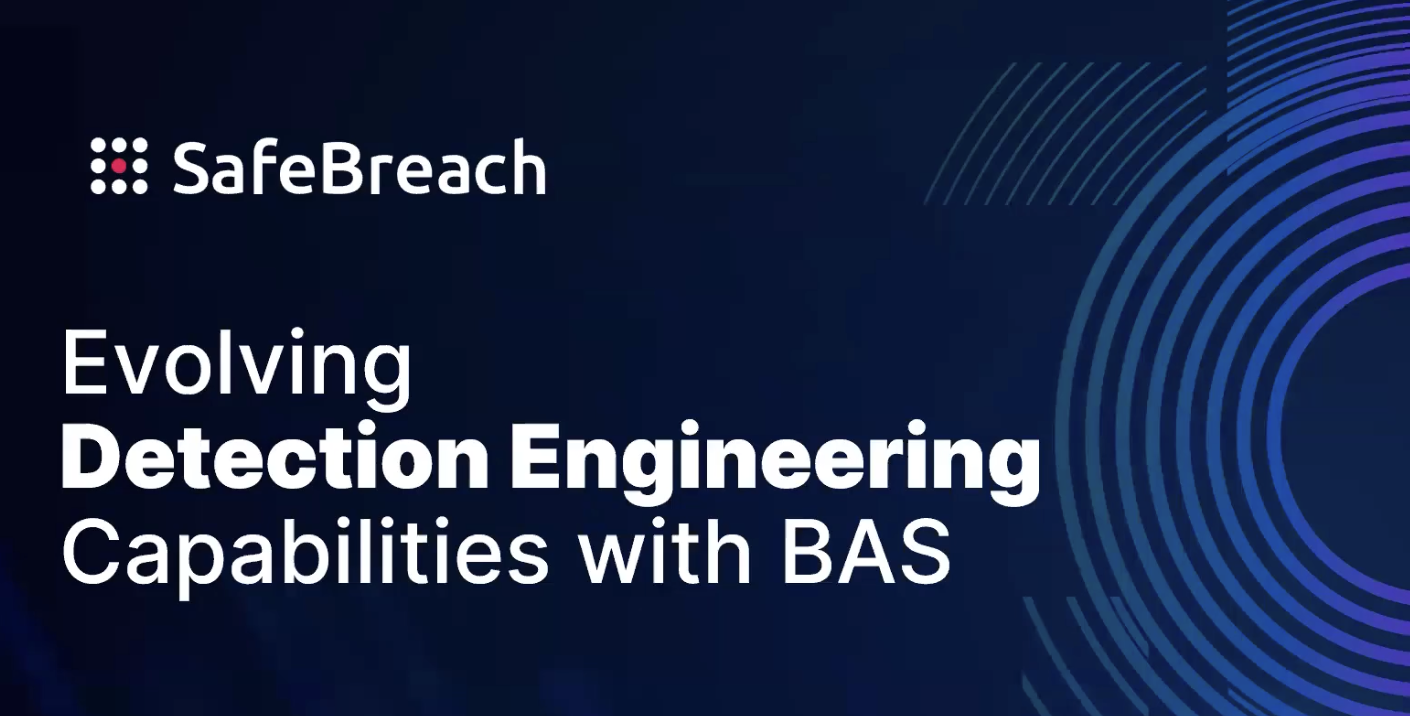How CTEM Optimizes Security Posture Beyond Traditional Measures
At its core, a CTEM initiative aims to strengthen an organization’s security posture through proactive actions that don’t stop at more traditional techniques like patching, signature updates, and pre-defined playbooks.
Instead, implementing a CTEM program means an organization is serious about moving beyond a tool-centric mindset that might neglect new and rapidly changing cybersecurity threats. This gives security teams the ability to lay the groundwork for a truly resilient and responsive security intelligence framework.

Experience the Power of a Truly Proactive Defense
The SafeBreach breach and attack simulation (BAS) platform puts your defenses toe-to-toe against over 30,000 attack methods to provide unparalleled visibility into your security posture. See why some of the largest enterprises in the world trust SafeBreach to help them proactively identify and remediate vulnerabilities.
How CTEM Can Benefit All Organizations
Large Enterprises
Large enterprises often grapple with vast and complex IT infrastructures, making them prime candidates for the benefits offered by a CTEM program.
The sheer scale and distributed reach of their operations means they are likely to encounter a wider array of threats—from sophisticated cyberattacks to insider threats. Implementing CTEM allows these organizations to gain comprehensive visibility into their threat environment, helping to enable a more efficient allocation of resources to address the most pressing vulnerabilities.
Moreover, the proactive nature of CTEM ensures that these organizations remain secure as they grow and adapt to new technologies, markets, and business models.
Regulated Industries
Organizations operating within regulated industries, such as finance, healthcare, and energy, face stringent compliance requirements and are frequent targets of cyberattacks due to the sensitive information they handle.
A CTEM program is particularly beneficial for these organizations because the model facilitates proactive risk and compliance management. By continuously identifying and mitigating threats, regulated industries can demonstrate to auditors and regulators that they are actively working to protect sensitive data and comply with industry standards.
This not only helps avoid penalties for non-compliance but also builds trust with customers and partners by showcasing a commitment to security.
Technology and Service Providers
Technology and service providers rely heavily on their IT infrastructure to deliver services and products to clients. Any disruption caused by a cyberattack can lead to significant downtime, loss of revenue, and erosion of customer trust.
Implementing a CTEM program helps enable these providers to protect client data effectively and ensure the reliability of their services. By adopting a more proactive approach to threat management, technology and service providers are more able to prevent breaches, safeguard their reputations, and maintain customer confidence.
Organizations Looking to Reach the Next Level of Cybersecurity Maturity
For organizations aiming to level up their cybersecurity maturity, CTEM also offers a structured pathway.
By systematically identifying, assessing, and mitigating risks, these organizations can adapt their security strategies to keep pace with evolving threats. For example, a CTEM program can help these security teams ensure that their security measures are continuously refined and strengthened, providing a solid foundation for long-term cybersecurity resilience.
Additionally, the insights gained from CTEM can inform operational and investment decisions, enabling organizations to invest wisely in security technologies and practices that offer the greatest return on investment.
The Five Stages of CTEM
Armed with a strong foundation of how CTEM can help and where it can take your organization’s security posture, let’s talk about how to get it implemented. Implementation can occur over the course of five steps:
1. Scoping
Defining the scope of the CTEM program is the foundational step, setting the boundaries for what systems, networks, and applications will be included in the assessment and protection efforts.
This stage involves a thorough inventory of assets (including hardware, software, and data repositories) to understand the full extent of the digital landscape that needs to be secured.
It’s crucial to consider not only the current state but also future growth and technological adoption plans to ensure the CTEM program remains relevant and effective over time. Engaging with stakeholders across different departments can provide valuable insights into overlooked assets or upcoming projects that should be incorporated into the scope.
2. Discovery
Once the scope is clearly defined, the discovery phase begins, leveraging automated tools and manual assessments to identify vulnerabilities within the scoped environment.
This phase is about understanding the current security posture by assigning assets their own risk profiles based on the presence of misconfigurations, insufficient security controls, and other weaknesses that could be exploited by adversaries.
The discovery phase is iterative, requiring regular reassessments as new vulnerabilities emerge and the threat landscape evolves.
3. Prioritization
With a comprehensive list of vulnerabilities identified, the next step is prioritization.
Not all vulnerabilities pose the same level of risk, and resources are often limited, making it essential to focus efforts where they will have the most significant impact. This phase involves assessing each vulnerability based on criteria such as the ease of exploitation, the potential impact on the organization, and the value of the asset being protected.
Risk scoring models can aid in quantifying these factors, enabling security teams to rank vulnerabilities and allocate resources efficiently. Effective prioritization ensures that the most pressing issues are addressed promptly, reducing the overall risk to the organization.
4. Validation
After implementing controls, changes, or fixes to address the prioritized vulnerabilities, the validation phase verifies their effectiveness. This involves repeating the discovery process to confirm that the remediations have successfully mitigated the identified risks.
Breach and attack simulations (BAS), using tools like SafeBreach, play a crucial role by providing a safe environment to test the resilience of the updated security measures against simulated attacks.
This phase is not a one-time event but an ongoing process to ensure that the security posture remains strong as new threats emerge and the organization evolves. Continuous validation helps to fine-tune the security strategy, ensuring that it adapts to changing conditions and maintains its effectiveness over time.
5. Mobilization
The final stage, mobilization, focuses on implementing the necessary changes across the organization and ensuring that all stakeholders are aware and involved in the process. This includes updating policies and procedures, training staff on new protocols, and integrating the lessons learned into the broader security culture of the organization.
Effective communication is key in this phase, as it ensures that everyone understands the importance of the CTEM program as well as their role in maintaining a strong security posture. Mobilization also involves monitoring and adjusting the program based on feedback and performance metrics, creating a cycle of continuous improvement that keeps the organization ahead of emerging threats.

How CTEM Benefits Your Security Program
So why invest the time, resources, and effort into making a shift to CTEM? Here are just some of the most notable benefits to your organization’s security program:
Stronger Security Posture
CTEM shifts your security posture from reactive to proactive risk management, which marks a critical evolution in cybersecurity strategy.
Traditional approaches often respond to threats after they’ve been detected, leaving organizations vulnerable to the rapidly evolving cyberthreat landscape. In contrast, CTEM emphasizes continuous threat monitoring and identification. This enables early detection of potential vulnerabilities and threats, which can mean:
- Faster, more secure digitalization and adoption of software-as-a-service (SaaS)/cloud services
- Improved response times and mean time to respond (MTTR)
This proactive stance allows organizations to take preemptive actions, significantly reducing the likelihood of successful cyberattacks and fostering a culture of preparedness and resilience within the organization.
Cost Reduction
By prioritizing threats based on their potential impact and the organization’s specific risk tolerance, CTEM enables a more efficient allocation of security resources.
This targeted approach ensures that efforts and investments are directed toward the most critical vulnerabilities, maximizing the effectiveness of security measures. The result is a more streamlined and cost-efficient security program, in which resources are not spent on low-priority threats but are instead focused on areas of highest risk.
Improved Visibility and Control Over Attack Surfaces
CTEM also contributes to building a more resilient cybersecurity posture by continuously refining and strengthening security measures in response to the evolving threat landscape. This resilience is crucial for withstanding cyberattacks and minimizing their impact.
By adopting a CTEM approach, organizations can ensure that their cybersecurity strategies are dynamic, adaptable, and capable of responding effectively to new and emerging threats.
This resilience is further enhanced by the integration of advanced security practices and technologies, such as machine learning and artificial intelligence, which can provide deeper insights into threats and vulnerabilities.
Enhanced Compliance
For organizations operating in regulated industries, maintaining compliance with various cybersecurity standards and regulations is paramount.
CTEM supports meeting and maintaining compliance by providing a structured, ongoing process for identifying, assessing, and mitigating risks.
Finally, the ability to document and report on the continuous improvement of security posture can strengthen an organization’s position with regulators and stakeholders alike.
CTEM Implementation Best Practices
While every organization’s CTEM implementation journey will be unique to its needs and requirements, several best practices can aid and guide the implementation:
Broaden Exposure Management Scope
Design your CTEM program to manage a wide range of exposures that could impact your business operations.
In other words, move beyond creating a vulnerability inventory and instead work to incorporate a holistic view of potential enterprise threats, including those posed by third-party vendors, supply chain risks, and emerging technologies.
This comprehensive approach ensures that no aspect of your organization’s digital ecosystem is overlooked, providing a more robust defense against cyberthreats.
Enhance Security Insights Across Teams
Ensure CTEM outputs (risks, priorities, and mitigations) are presented in a way that provides valuable insights for secure-by-design initiatives and other processes for strengthening a security culture.
This can extend to encouraging cross-functional collaboration by integrating security findings into broader organizational discussions, enabling teams outside of IT to understand their roles in cybersecurity efforts. This fosters a culture of shared responsibility for security, in which every employee becomes part of the solution.

Incorporate Emerging Security Areas
From staying on top of the latest developments in cybersecurity to considering zero-trust architectures and cloud security best practices, your security team can strengthen your CTEM program against evolving threats.
The same applies to your security tools; look for a platform that commits to meeting a 24-hour or less service level agreement (SLA). This means that your enterprise is protected as soon as new threats are identified.
Phased Deployment and Integration
Adopt a phased approach for implementing CTEM technologies, beginning with familiarization and gradually advancing to risk gap analysis. From there, integrate CTEM processes into other organizational and security workflows.
This gradual rollout minimizes disruption to daily operations and allows for adjustments based on feedback and performance metrics. It also facilitates smoother integration with existing systems and processes, ensuring that CTEM becomes a seamless part of your organization’s cybersecurity strategy.
Implement Continuous Threat Simulation and Environment Optimization
Continuously update threat intelligence and use BAS to run real-world attack scenarios that recreate threats to see how security tools perform.
BAS helps proactively assess an organization’s security posture by simulating real-world attack scenarios, identifying vulnerabilities before they are exploited by cybercriminals, and highlighting areas for improvement. Additionally, by leveraging tools such as SafeBreach, your security team can better mitigate risks associated with lateral movement within the network, validate detection rules, and enable organizations to prioritize vulnerabilities based on their potential impact and exploitability.
Encourage Stakeholder Engagement
Build support among key stakeholders to facilitate effective implementation and ongoing maintenance of the CTEM program.
Engage with executives, department heads, and frontline employees to ensure everyone understands the importance of cybersecurity and their role in maintaining a strong security posture. Regular communication and training sessions can help keep all parties informed about the program’s progress and any changes in the threat landscape, fostering a collaborative environment where security is a shared responsibility.
Create an Actionable Reporting Mechanism
Establish a method for regular reporting and tracking progress. Tools like SafeBreach’s security posture optimizer score can help quantify and track improvements.
Your team can use these figures to then develop clear, concise reports that highlight key metrics and trends, making it easier for decision-makers to assess the effectiveness of the CTEM program and identify areas for further investment or adjustment.

Learn more about this growing cybersecurity discipline and how BAS can help establish or optimize a detection engineering program.
Continually Evolving Your CTEM Program
Taking on a CTEM initiative addresses the necessity of identifying, mitigating, and outpacing evolving threats by offering a systematic method to balance immediate remediation needs with long-term security objectives.
However, a thriving CTEM program necessitates cooperation between security teams and operational stakeholders to define and refine the program’s scope as your business grows and evolves. Over time, this collaborative effort empowers organizations to develop a more exhaustive and resilient CTEM program that spans all elements of Gartner’s high-level maturity model as they transition from the “Establishing” phase to the “Optimized” phase.
Get Started with a Powerful BAS Platform
By embracing CTEM, businesses can make a huge leap toward strengthening their security postures, reducing costs associated with breaches, and ensuring compliance with industry regulations.
BAS platforms, such as those provided by industry leaders like SafeBreach, play a critical role in the CTEM lifecycle. These platforms enable organizations to simulate real-world attack scenarios, identify vulnerabilities before they are exploited, and highlight areas for improvement.
By integrating BAS into the CTEM framework, organizations can achieve a more dynamic and responsive security posture that is better equipped to face the challenges of tomorrow.
Want to discover how SafeBreach can empower your organization’s CTEM efforts? Request a personalized demo today to explore the capabilities of our platform and learn how it can help you stay one step ahead of tomorrow’s cyberthreats.

